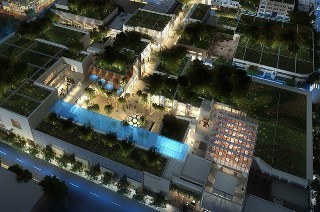Apr 24 2015
Palm Court, the second phase of an ambitious expansion of the Miami Design District, has been certified LEED Gold for Core + Shell by the US Green Building Council. As the master architect/architect of record for the project, SB Architects worked closely with sustainability consultants The Spinnaker Group to achieve this milestone.

Palm Court achieved 62 LEED points out of a possible 110, qualifying it for Gold certification. The Design District as a whole has already achieved LEED for Neighborhood Development designation. Developed by Miami-based DACRA Development, this first phase of expansion has had a profound impact on the district and the city of Miami.
Administered by the USGBC, LEED - Leadership in Energy & Environmental Design - is the most widely-used green building rating system in the world, recognizing best-in-class building strategies and practices. LEED certification provides independent verification of a building or neighborhood's sustainability, evaluating the design, construction, operations and maintenance of resource-efficient, high-performing, healthy, cost-effective buildings. (Source: www.usgbc.org)
Within the two blocks that make up this phase of development, the design and development team embarked upon a whole new way to approach retail design and architecture. Although the project was developed and designed as a cohesive whole, it is decidedly not a mall. SB Architects created the architectural skeleton for the blocks, addressing building structure, overall identity and the movement of people through the space. Within this framework, each store has been treated as a distinct building, with individual retailer given the opportunity to create the entire façade – 45 feet from ground to sky. This project is a paradigm shift of sorts, pushing the envelope of retail design, and acting as a model for the future. LEED Gold certification ensures that the development is a model of sustainable design as well.
Several elements of the development and design of Palm Court played particularly important roles in the project's sustainability. Set in the heart of the city's existing Design District, Palm Court utilizes an infill site, capitalizing upon development density, community connection and access to public transportation. The team also implemented Tenant Design & Construction Guidelines to ensure that its luxury retail tenants building out their spaces sustainably, matching the sustainability goals for the overall project. The team also managed construction waste, used recycled, locally-sourced and sustainable materials, optimized energy performance, and utilized systems to reduce water use. Nearly every roof in the development is planted as a green roof, providing not only thermal cooling, but a stunning rooftop landscape design mimicking past hurricane patterns over Miami, viewable from the airline flight path that runs directly above the site.
Palm Court also achieved several "Innovation in Design" credits in the "Exemplary Performance" category for going above and beyond the standard threshold for numerous criteria. The project provides 50% more open space than required by the zoning codes, maximizes access to alternative transportation with immediate proximity to multiple bus lines providing over 200 stops per day, and locates 100% of parking spaces under cover. In a particularly impressive intersection of art, architecture and sustainability, visitors exit the project's underground parking by emerging through a faithful re-creation of Buckminster Fuller's Fly's Eye Dome placed prominently on the project's south plaza.